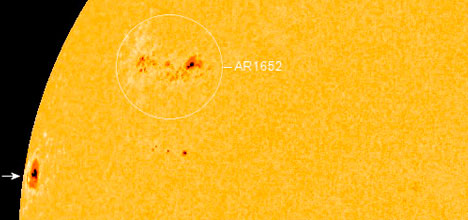Losing track of time, discovering gaps in sentences where you have misplaced words, time and space appear to be on a wobble, and the day simply disappears.
According to one researcher these symptoms and a number of others, including feeling agitated and uneasy, are caused by solar flares.
Solar flares effect people's mental and physical health.
And with the Space Weather website predicting there is a good chance of major solar flares over the next 24 hours, we can look forward to more of it.
There appears to be a direct connection between the Sun's solar storms and human biological effects especially after an "M" class solar flare, say researchers.
Global electromagnetic resonance is named after physicist Winfried Otto Schumann who predicted it in 1952. Schumann resonances occur because the space between the surface of the Earth and the conductive ionosphere acts as a closed waveguide.
The fundamental mode is a standing wave in the Earth–ionosphere cavity with a wavelength equal to the circumference of the Earth. This lowest-frequency and highest-intensity mode of the Schumann resonance occurs at a frequency of approximately 7.83 Hz, but this varies under the impact of solar flares on the ionosphere, which comprises the upper wall of the closed cavity.
In recent years, scientists are finding the Earth's magnetic fields are far more significant than they previously thought. They now know that the human brain contains 'millions of tiny magnetic particles.” These particles connect us to the Earth's magnetic field in a powerful way as a human antenna.
It has now been discovered the magnetic fields have a profound influence not only on human consciousness, but also on the human nervous system and immune system.
US researcher Helen Celini says many people are reporting feeling heart palpitations and irregular heartbeats. Some people are reporting feeling heating sensations in the body, others of feeling cold.
Solar flares are also now being blamed for people being nervous, anxious, worrisome, jittery, dizzy, shaky, irritable, lethargic, exhaustion, short term memory problems and heart palpitations, feel nauseous, queasy, and to have prolonged head pressure and headaches.
The remedy is to drink extra water when the earth is being affected by solar flares, and to reduce the caffeine intake.
Solar flares can also wreak havoc with technology such as computers.
National Oceanic and Atmosphere Administration forecasters on Tuesday estimated a 40 per cent chance of M-class flares and a five per cent chance of X-flares during the next 24 hours. The most likely source is sunspot AR1652; it has a 'beta-gamma' magnetic field that harbours energy for M-class eruptions.
Also of interest is the large sunspot emerging just south of AR1652. Denoted by an arrow, the unnumbered region is crackling with C-class solar flares and based on its size, the forecasters say it could be capable of even stronger eruptions.
More will be known by the end of the week as the sunspot turns towards, giving a more direct view of the kind of magnetic field the sunspot possesses.



1 comment
SOLAR CYCLE
Posted on 11-01-2013 17:16 | By TERMITE
The sun has a cycle of sun spot activity and that normally spans about 11 years. The spots come from the twisting of the suns magnetic field and represent the point of entry/exit of these magnetic lines. The more twisted they become the more spots and the more surfaces activity such as solar fares. Most solar fares simple flare up and sink back to the surface of the sun, but if large enough sometimes a large amount of ionised particles and more are able to escape the suns atmosphere and charge out into space and if the Earth is in the way of this then is can have a significant effect on: radio, electrical grids and things electronic. The effects can also be seen from the northern/southern (Aurora Borealis/Aurora Australus or the northern lights/Southern lights) is where all of these particles collide with the Earth's atmosphere. They can be spectacular but can also be harmful if strong enough. The Sun spot activity is expected to reach its peak in the middle of 2013.
Leave a Comment
You must be logged in to make a comment.